Pirates. The word conjures so many images: Leering skulls upon tattered black flags. Dingy old maps marking the secret locations of fabulous treasures. Flamboyant men waving cutlasses and flintlocks, swinging from one deck to another amid the thunder and smoke of guns as battle is joined.
The iconography surrounding pirates is so well known, so ingrained in our minds that the mere glimpse of a sneaky fellow with an eyepatch is enough to peg the man as a pirate. An actual peg below the knee will do the same, of course. Fictional pirates promise action, drama, adventure…the stuff of imagination.
Pirates tend to exist in the popular imagination as colorful rogues living lives of independence, but their subsistence depended upon stealing ships and goods from other people and, often, killing them.It is no wonder, then, that pirates show up so often in movies, TV series, comics and literature. One place pirates seldom appear, however, is on lists of great crime fiction. We see lists of the best classic mysteries, the best crime books of this decade or that, the best crime fiction set in England or France or the Scottish Highlands, etc., but pirate literature seldom shows up on any of them. This seems amiss, as pirates were, in fact, criminals. They tend to exist in the popular imagination as colorful rogues living lives of independence, but their subsistence depended upon stealing ships and goods from other people and, often, killing them.
A good pirate tale, then, ought to appeal to lovers of crime fiction on several levels. Admittedly, the murders committed by fictional pirates tend to not be particularly mysterious, as a sea thief often will skewer or shoot his victim in front of multiple witnesses and even brag about the bloody deed later when passing a jug of rum. But aside from that, there are plenty of conspiracies, double crosses, break-ins and swindles to go around. Toss in a highly sought valuable bauble or secret map, or perhaps a good revenge quest, and you’ve got plenty of reasons to keep the swashbuckling going at full tilt—and plenty of plot points and character types that ought to make crime fiction fans feel like climbing aboard.
Here, then, is a look at a few pirate novels that might appeal to lovers of crime fiction.
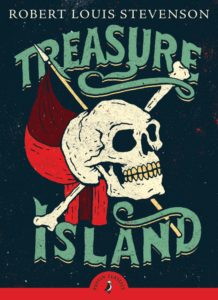
Robert Louis Stevenson, Treasure Island
It is the first pirate book that springs to mind, of course, but deservedly so, for it set the template by which all other piratical novels are judged. It functions well as a mystery, too, as young Jim Hawkins encounters first a mysterious sea captain hiding out at the Admiral Benbow Inn. Young Jim knows the man is hiding secrets, and fears being found out by other seafaring men. Upon the captain’s death, Jim and his mother find a map in the old man’s sea chest. Some local men of note soon invest in a ship, and Jim embarks with them on a race for buried pirate treasure.
They are joined, of course, by one of fiction’s great sea thieves—Long John Silver. The one-legged sea cook and others among the crew are, in fact, pirates traveling in disguise as crewmen aboard the Hispaniola in hopes of acquiring the treasure for themselves. Jim finds himself in the role of amateur detective, slowly piecing together elements of the conspiracy, while Silver tries to hold together the strands of his criminal scheme. Along the way we get plot twists, skullduggery, double crosses, close calls and great escapes, as Jim wonders just how much he can trust the apparent bond between himself and Silver. It’s all a fine high seas caper.

Michael Crichton, Pirate Latitudes
This novel, found on the author’s computer after his death, is a fun read, although not perhaps as polished as Crichton’s other work. Apparently, he had been working on it for quite some time, and one can only wonder what he might have done with it had he lived longer.
As it is, though, “Pirate Latitudes” is a solid escapist novel of crime in the Caribbean of the 17th Century. Capt. Charles Hunter is hired by Jamaica’s governor to raid an island fortress and steal a Spanish galleon filled to the brim with gold and other treasure.
Hunter, much like the brainy leader in any good heist movie, assembles himself a diverse crew of highly skilled sea crooks and sets off for the raid on the island of Matanceros. There are other people who want that treasure for themselves, of course, and so there is much backstabbing and betrayal and bloodshed. Crichton’s pirates are decidedly different from those of Disney’s “Pirates of the Caribbean” movie franchise and a good deal courser than Stevenson’s rough fellows. If you like a good heist movie, or a fast-paced violent tale, this book may be just the thing for you.
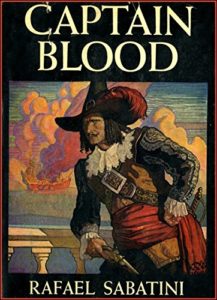
Rafael Sabatini, Captain Blood
This entry is a bit different from those mentioned above, as the former primarily feature characters who chose lives of crime. Sabatini’s protagonist Peter Blood does not aspire to be a criminal at all. When we meet him, Blood has traded his life of soldiering and sailing for that of a country physician. After tending to a couple of fellows wounded while fighting on behalf of the Monmouth Rebellion, however, Blood is found guilty of treason and sentenced to penal servitude in the Caribbean. His eventual escape from that fate leads him to a life of piracy and swashbuckling. He becomes the “scourge of the high seas,” but he always manages to adhere to his own code of ethics and honor.
Captain Blood is sort of a Robin Hood figure, cast as a criminal by the corrupt officials he badgers. Readers who enjoy the novels Leslie Charteris wrote about the Saint likely will find Peter Blood to be a kindred spirit to Simon Templar.
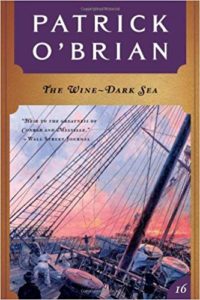
Patrick O’Brian, The Wine-Dark Sea
All of the stories O’Brian wrote about Capt. Jack Aubrey and his friend Stephen Maturin, the physician and spy, are worth a read for their rich depictions of British nautical life during the Napoleonic Wars. This one, though, the sixteenth in the series, finds Lucky Jack and his crew doing battle with pirates. It’s a stunning blend of history, sea adventure and espionage with Aubrey’s ship at one point sailing under the guise of a privateer (pirates, sort of, but with a license from one nation to prey on the ships of others). It’s as rich, complex and immersive as any John Le Carré spy novel, and if you love this one you’ll want to read them all.
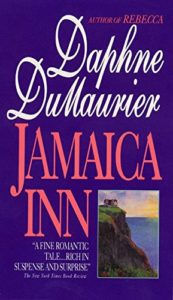
Daphne du Maurier, Jamaica Inn
Wreckers, dastardly criminals who lure ships onto dangerous rocks and then plunder the wreckage, are not pirates, of course, but they live by plundering ships and so deserve a spot on this list. A young woman travels to live with her only surviving relative and soon finds herself trying to get to the bottom of the mysterious goings-on at the lonely Jamaica Inn. As dark and atmospheric as any good gothic novel and full of schemes and bloody deeds, this one is a great read for a dark rainy night.
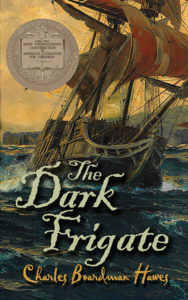
Charles Boardman Hawes, The Dark Frigate
It was written for young audiences, but The Dark Frigate is a fine read at any age. This novel is set in the 17th Century and follows the adventures of a young man, Philip Marsham, who flees London after a horrible gun accident. He signs up as a crewman on the Rose of Devon only to see the ship later seized by pirates. We get pirate adventure and even a little courtroom drama as Philip and the pirate crew find themselves on trial. This novel won the Newbery Medal in 1924 and is quite the smashing read.

Robert Louis Stevenson, Robin and Ben: Or, The Pirate and the Apothecary
A poem, rather than a novel, this “startling moral tale to hear, of Pirate Rob and Chemist Ben, and different destinies of men.” The two grew up together but their paths diverged. In later life they meet and discuss their fates, this Robin who risks his own life and limb to steal from men who can fight back and this chemist Ben who enjoys the respect of his neighbors and society while surreptitiously selling watered-down medicines to improve his profit margins, and to hell with what may happen to his unlucky customers. Rob’s reaction to the apothecary’s approach is, shall we say, vivid and to the point.

















